Day 28, Sat, Feb 11th
Ango Hotel, Babati to The New Arusha Hotel, Tanzania, 175 km.
Short trip in on a picture perfect road. Passed untold numbers of safari vehicles crammed with tourists heading for camps for their sanitized view of Africa.
Speaking of sanitized, I am not far removed myself, maybe a bit ahead of the folks flying over at 35000 feet. Yes, I have seen and learned a lot but the complexity of these societies as I drive by means that I can only scratch the surface.
They work in myriad ways. Take the Masai tribesmen I pass early in the morning in the middle of nowhere minding their herds; no canteen, no back pack, just a stick, their machete and a colourful robe. Where do they sleep? What do they eat? Don't know.

Compare that to our stressed out societies at home all trying to keep up with each other and chase the almighty buck. Many are unhappy, up to their necks in debt and feeling good about treading water. These tribes seem at peace with themselves and the environment around them. They may be poor monetarily and with regard to asset accumulation but they may be far richer in other ways. Don't know the answer to that one either.
Witnessed many, many starving livestock driving in to Arusha as a result of the water drought which has to be affecting the wild ones too.
Saw Mt Meru on the way in all 14,000 feet of it and thought it was Mt. Kilimanjaro so will have to wait for that one!
In the afternoon Waan and I visited the African Cultural Center art gallery. There should have been a cover charge, it was that good; apparently the largest art gallery in Africa.

We oogled Mike Ghaui's beautiful paintings and sculptor exhibits all for sale. It is so expensive you have to inquire in person.

Day 29, Sun, Feb 12th
New Arusha Hotel to The Wild Frontiers Lodge, Serengeti National Park by 4X4.
After a 2 hour plus ride departing at 6 am we get to the Ngorongoro Crater which is an approx 20 km diameter crater with 50,000 animals living in very rich grasslands. The short and skinny is that we saw 4 of the big 5 - elephants, cape buffalo, rhino (6 of 26 in the area) and lions (7 of approx 60 comprising 5 prides) missing only the leopard.

A few words about the Ngorongoro Crater (NC) which is responsible for all of the savanah grasslands in the Masai Mara and the Serengeti. Many millions of years ago 7 volcanoes created 7 peaks over different time periods. This one is called a 'caldera' for the reason that it is the only major non water filled volcano area in the world. It has collapsed into itself and unlike most others has not filled with water thus creating the rich diversity of wildlife we are seeing.
In addition, during the eruptions the magma ash, sodium bicarbonate which is alkali based got spread over a huge area. In time it became brittle, rock like and encouraged the growth of grasslands and prohibited large forest growth (hard for roots to grow) so vast plains ensued allowing the harvest of grazing opportunity for so many species.
The NC is a magnificent flatlands surrounded by massive hills 2000 and up to 3000 feet high from base elevation; some animals even migrate into and out of this crater! Why they would ever want to leave given the richness of the grazing opportunities I do not know. As opposed to being out in the flatlands, the viewing of the surrounding area with its topographical elevation variations is simply stunning especially in the later afternoon with the sun creating shadows everywhere.
Day 30, Mon, Feb 13th
The Wild Frontiers to Flycatcher Camp, 4X4.
Our lodgings and viewpoints at Wild Frontiers on the side of the crater were stunning and so they should be as the rack rate is expensive and includes three meals and I guess that includes a tour of the crater.
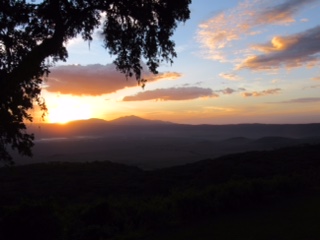
We re-traced our route back through the crater and up the other side to the steep, steep exit. I actually buckled up with the dangerous drive and the road was built with paving stones to accommodate the elevation climb. We worked our way through hours of dry, dusty grassland outback towards the Serengeti Planes. We saw lots of Masai tribesmen and enjoyed the village life as we proceeded. While we worked for our sightings, there were many and sometimes we were just plain lucky. We ran across a small pride of 4 lions relaxing under some Acacia trees and stopped for quite awhile to observe their antics with what looked liked full stomachs. We also enjoyed watching the interactions and eating habits of many giraffe.
Speaking of Acacia trees, it is an indigenous tree to Southern and Central Africa and extremely hardy, also quite lovely to look at with its large canopy interlocking with other Acacia canopies. The tree is also very smart. Low down it is thorny as hell and I have inadvertently scratched myself numerous times on thorns that are far sharper than a sewing needle. Higher up, past a giraffes reach for instance it no longer needs to protect itself and dipsenses with the thorny part.
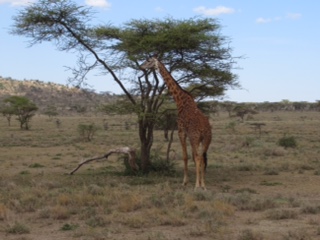
Speaking of hardy animals, take the Thomson Gazelle and Giraffe. Both elegant creatures, they can exist for long periods without water due to their adaptation to the vagaries of nature. They also find moisture in the most elusive places. The giraffe feeds on Acacia leaves which is hard to fathom due to the thorny nature of the tree. Their long, long tongues snake out, wrap around the greeny parts and suck it off while eluding the thorns, amazing to watch.
Though I did not fully understand the significance of the sighting of a Caracal cat I was soon updated by our excellent guide Simon. It was his best sighting of this animal ever and he only sees a creature like this 1 in 40 outings. This animal, about 50 lbs is characterized by the most interesting pointed and large ears.
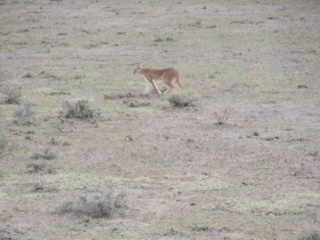
The highlight of the day involved a sighting late in the afternoon. At the 11th hour there was a low shriek from the front left hand seat from my wife. Leopard sighting so we got the last of the big 5. It was a special moment and privilege to be able to see this sleek animal in its habitat. Simon told us later that leopards are in fact far more numerous than lions but just much more elusive, so we were all surprised to hear that.
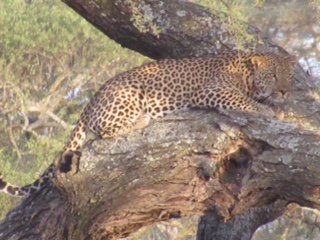
Day 31, Tue, Feb 14th
Flycatcher Camp to Sopa Lodge, Serengeti National Park, 4X4.
After breakfast we proceed through a ranger check point into the Serengeti (actually called Serenget which means plain without trees). It is dusty and rather uncomfortable due to the drought and lack of rainfall for a long period. The Serengeti is 15,000 square kilometres as comapred to the NC being 8,000 which also includes a large area outside the crater. The big deal was the Cheetah sighting, a mother and two offspring one male and the other female. To make it even more special they are on an extended walk, watching us closely and quite unafraid. We are transfixed. Later in the morning we see a solo cheetah under a shaded tree.
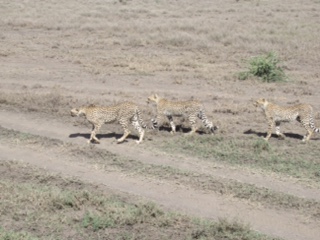
While the second part of the day was a bit anti climatic, it is judged a success by those far more experienced than me. We see a total of 31 lions in 9 visitations; most were lying lazily about with full stomachs and none reached the drama of the leopard or cheetah sightings. We reach this stunning 6* hotel called Sopa Lodges later in the afternoon all pretty dusty and ready for a swim, shower and good hair shampoo. It is on the side of a sloping hill looking down over the Serengeti plains. There are signs all over warning of wild animals and we are in a true Shangrai La.
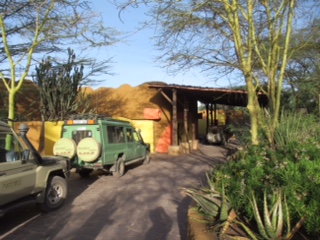
Day 32, Wed, Feb 15th
Sopa Lodge to The New Arusha Hotel, 4X4 and charter flight.
My favourite animal to look at is the Impala, pure beauty and symmetry, the colours along his flank imply speed and agility; the horns have an interesting shape and usefulness; the big chief, the alpha male is stronger and obviously more muscular than the rest. This morning we watched an amazing exercise. The dominant Impala, maybe the most majestic animal for me in all of Africa was herding his females maybe two dozen into an area getting ready for one of them to come in to heat; at the same time he was chasing down and separating the horny younger and smaller ones, working quite hard actually for his conquest.
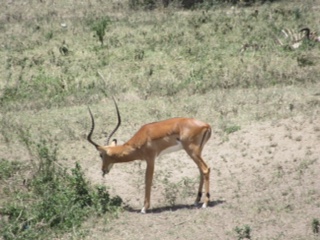
We have about a 3 hour ride through lots of wetland areas resulting in many animal sightings to finish off a splendid time with Simon K (Siburro in Swahili); we say fond and sad goodbyes.
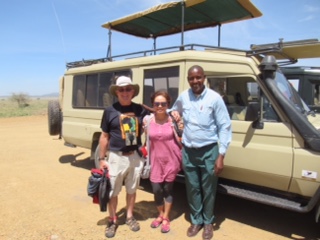
Day 33, Thur, Feb 16th
The New Arusha Hotel to Merrueshi Maasai Village, Kenya, 266 km.
We leave Arusha in convoy due to traffic and an uncertain waypoint. Out of town it becomes an enjoyable ride away from the traffic and working through some great twisties , likely the best yet. We skirt counter clockwise around Mount Kiliminjaro which is 19,000 feet rising from a floor of about 5,000 feet, pretty impressive. We get to the turn off and head right on a dirt track to the Maasai camp where we will be staying for two nights. It is a bit of a hairy ride and I am feeling tired when I come to a largish kids boarding school of 400 aged 8-14. I have an extra ball so stop on my goodwill mission; lots of excitment, the head guy all dressed up and waving a scary stick all over the place. It is a nice interlude.
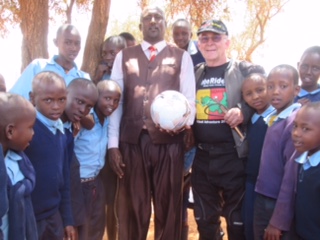
I keep going and discover that the slippy slidy stuff is getting a bit easier and actually make the camp without incident. The camp is headed up by a U.S. educated (Washington State)Maasai man called Kakutu and his brother Tom who are good friends of Helge's from 16 years ago. They cater to groups like us interested in Maasai culture.
We get a general run down of stuff and head out for a two hour late afternoon walk to scout out the local animals, very interesting. We return for dinner and drinks and walk out again around 10 pm to check out the local swamp only to get skunked.
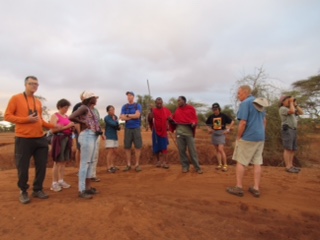
Day 34, Fri, Feb 17th
Merrueshi Maasai Village, 0 km.
Up at 6 am for a quick snack and out again for a 3 hour walk; it is exhilarating to be on a walkabout, no noise, tracking the animals with the Maasai guides, learning about animal habits, the local bird life, really cool stuff after the noise of a vehicle safari. We return for breakfast and then all get motorcycle tire tread sandals made by a local expert for $10 each plus tip; zero gets wasted. The guy is a real craftsman and can make three pairs out of one tire. Following that we have a long session with two tribal elders we guess to be in their mid 70's via an interpreter.
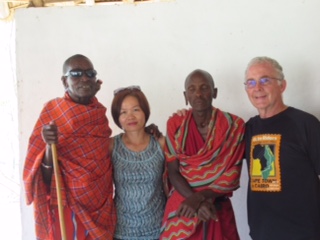
Following lunch we get visited by 10 lady elders all dressed up in their garb; there is not enough room here to go in to detail suffice to say that both gatherings were insightful and a learning experience about their complicated culture.
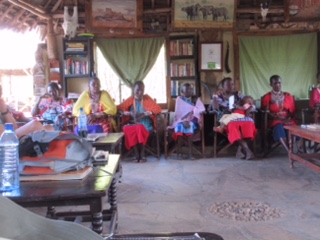
Evening walk to a Maasai village, most interesting; we go into 4 little homes, take pics, ask questions and generally get a great insight into their lifestyle. Helge has lived right here in this village for a month back in 2001. While we are first time visitors and a little taken aback by the rudimentary way of life he has a different perspective from long years of experience travelling in Africa. He feels that the people are doing just fine, they are coping well, living simple but happy and uncomplicated lives. He is an enthusiastic supporter of their lifestyle.
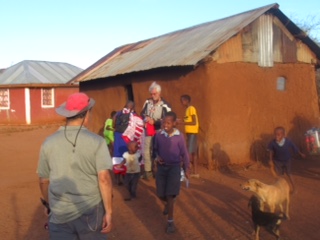
Serious problems could be on the horizon though. The terrible years long drought is eroding their ability to make a living which is based on raising cattle and goats and the more the better. However, it is very difficult to continue this tradition in the present circumstances. To make matters more difficult, the tradition of having as many children as possible is coming in to jeopardy because of the demands and costs of education. While a Maasai's wealth is measured in how many cattle and kids you have (but you can't ask them how many of each or what their ages are because it is bad luck and they apparently don't know!!??), this whole concept will be undergoing a profound change in the next generations.
One last neat little anecdote. Out of nowhere comes this sweet, sweet little girl, 12 years old (she will be married off at 15-18 for goodness sakes to a much older man) speaking near perfect english. Mister, are you the soccer ball man, yes, well we need another ball, why, because the big kids have gone off with the one at the school and the little kids need one too. How do you say no to that so my second to last ball was donated right there. She was a precocious little thing with great eye contact, determined and has a future in sales for sure.
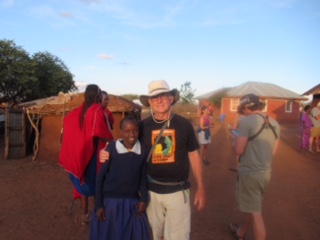
Day 35, Sat, Feb 18th
Merrueshi Maasai Village to Serena Mountain Lodge, Kenya, 319 km.
Clutch out at 7:30 to navigate the sandy stuff at the start. I am getting better with the slippy slidy bits. The journey is not long but we hit traffic like you wouldn't believe, bumper to bumper and a Saturday to boot. You get good at maneuvering up the center lane or taking the the pedestrian side when things get really slow. Circling Nairobi and thank goodness we did not have to go right in, we kept running in to these huge speed bumps right on 3 lane divided highways for petes sakes! Vehicles have to slow down to a crawl on 70 mph freeways which is crazy with huge back ups and my panniers are too wide to negotiate in between lanes.
The Serena Mountain Lodge is an idyllic place way up in the mountains and we will be here two nights and explore tomorrow.
We have had a superlative time with the piped in girls who have meshed very well with our group. Danielle (Aaron), Carolyn (Mac), Lisa (Helge) and Waan have really added to the joy of our trip and given poor, out numbered Debbie (Harrison) a good break from all of the male fellow travelers! I cannot really describe in words how important it is for a team to jell well together. We were doing great before they arrived and they just added immeasurably to everything.
Day 36, Sun, Feb 19th
Serena Mountain Lodge.
After breakfast we went on a nature walk until just before lunch. We were treated to all sorts of fascinating insights into the rain forest surrounding us right below massive Mt. Kenya- fig trees and how they germinate and slowly strangle their inside tree with its massive vines; all sorts of dung droppings and how various insects make use of it. Our leader was very well informed and accompanied by a guard armed with a high powered weapon for protection.
The rest of the day was relaxing and pleasant. Late in the afternoon my very good friend from Nairobi Chris Banks, our chase vehicle guide Simon Peterson and I were sitting up in the viewing area having a beer and chatting. Simon at 29 is wise beyond his years, gifted really. Chris has an encyclopedic knowledge of wildlife and all things Africa. For over an hour I was enthralled listening to them trade stories and ideas back and forth. It was a special moment for me.
Then, suddenly, there were two (giant eagle) owls in the trees at a distance of maybe 200 feet; then they were mating, wow and we were the bystanders! Simon has this Canon 65X zoom camera and I was able to look at them close up. The crowning moment was when one of them flew closer down to the waters edge of the pond. He had a large frog in his mouth! Then, simple as can be, he flips it lengthways in his mouth and swallows it whole! It was a another neat moment.
Last thing. Early morning about 4 am we awake to hear and watch 14 elephants at the watering hole outside our bedroom window. There they are all grumbling, eating, drinking and one or two roaring at each other, pretty cool.
|